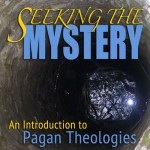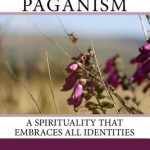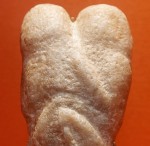As promised, an excerpt from Seeking the Mystery: An Introduction to Pagan Theologies, now available in both e-book and paperback editions.
Excerpt from Chapter Four: Life, Death, and the Human Body
The Multiple Soul
Pagans have a range of beliefs about the human soul that parallels their beliefs about divinity. Some Pagans see the soul and the body as being completely identified—the soul is the body and the body is the soul, in the same way that pantheists believe that God/dess is the world and the world is God/dess. Others share the common Western belief that the soul is influenced by the body, but is more than the body, and will continue on in altered form after the body’s death (similar to panentheists’ belief that God/dess is in the world, and the world is in God/dess, but God/dess is more than the world). A third view is that personhood exists only in the body, and that there is no spiritual substance we can meaningfully call a “soul” (similar to the nontheist position).
The theology of multiple souls is gaining prevalence in the Pagan community, however. In this model, human beings have multiple spiritual essences that serve different functions. This notion is found in a number of religious traditions. Scholar Claude Lecouteux describes its appearance in ancient and medieval Northern European religion, where people were thought to have three spirits. The fylgja was an individual’s double that also served as a protective guardian spirit; the hugr was the active force of the individual that carried his or her personality out into the world; and the hamr was an inner spiritual form that determined a person’s outward appearance, but was also capable of traveling outside the body.[i] In ancient Egyptian religion, a person was thought to have three souls (the ka, the ba, and the akh), as well as other spiritual components such as the heart and the name, each of which had different functions in life and in the afterlife.[ii] In the charming book The Traveller’s Guide to the Duat, Kemetic reconstructionist Kiya Nicoll details the preparation the parts of the human being must undergo for being separated at death, transformed, and reintegrated in the land of the dead. The body is carefully preserved and left behind in the living world, where its persistence supports the stable and happy existence of the deceased’s transformed and reassembled self.
A somewhat less complex multiple soul model can also be found in the Western ceremonial magick practiced by some contemporary Pagans. Many forms of ceremonial magick borrow from Jewish mysticism, where the three parts of the soul are known as nefesh, ruach, and neshamah. Simply put, the nefesh is the animal self, the ruach is the human self, and the neshamah is the divine self that survives death. Craft teachers Victor and Cora Anderson derived a similar three-soul model from Hawaiian Huna, in which the animal self is Unihipili, the human self Uhane, and the divine self Aumakua. Their writings on the subject were published in a volume entitled Etheric Anatomy, and were also spread by Starhawk in The Spiral Dance, where she names the selves Younger Self, Talking Self, and Deep Self. In the Andersons’ model, the body is thought to be of the same substance as the selves, only made of denser matter. Fostering communication and cooperation between the selves (including the body) is necessary for spiritual health, as well as for the effective practice of magick.
In multiple-soul models, the souls have different fates after death. Pagans who also believe in reincarnation tend to identify the “divine” self as the part that reincarnates, not the “human” self (which holds the personality of a single lifetime) or the “animal” self, both of which may return to the earth after the death of the body. In some traditions, it is believed a traumatic death may cause the separation of the souls from the body to go awry, and the animal or human selves may remain stranded on the material plane as ghosts. These stranded souls are merely echoes of a person, however, as the divine part of the self has already moved on. This belief is similar to that in Chinese religion, where the p’o soul can become angered and transform into a demon if not properly treated after the body’s death.[iii] Some Pagans also embrace the spiritualist belief that after death, one or more parts of the soul travel in the spiritual realms for a time before incarnating into a new human body. Reincarnation beliefs influenced by Spiritualism, Buddhism, and Hinduism are common in the Pagan community, and they are often combined with images of the underworld or afterlife realms from ancient religions. For many contemporary Pagans, these realms are temporary resting places where the soul or souls review the life just lived and choose whether to return to earth.[iv]
[i] Claude Lecouteux, The Return of the Dead: Ghosts, Ancestors, and the Transparent Veil of the Pagan Mind, trans. Jon E. Graham (Rochester, VT: Inner Traditions, 2009), 162-180.
[ii] William J. Murnane, “Taking It With You: The Problem of Death and Afterlife in Ancient Egypt,” Death and Afterlife: Perspectives of World Religions, ed. Hiroshi Obayashi (Westport, CT: Praeger, 1992), 35-48; see also Jeremy Naydler, Temple of the Cosmos: The Ancient Egyptian Experience of the Sacred (Rochester, VT: Inner Traditions, 1996).
[iii] Judith A. Berling, “Death and Afterlife in Chinese Religions,” Death and Afterlife: Perspectives of World Religions, ed. Hiroshi Obayashi (Westport, CT: Praeger, 1992), 182.
[iv] See Janet and Stewart Farrar, The Witches’ Bible (Custer, WA: Phoenix Publishing, 1981, 1984), II.115-134.











